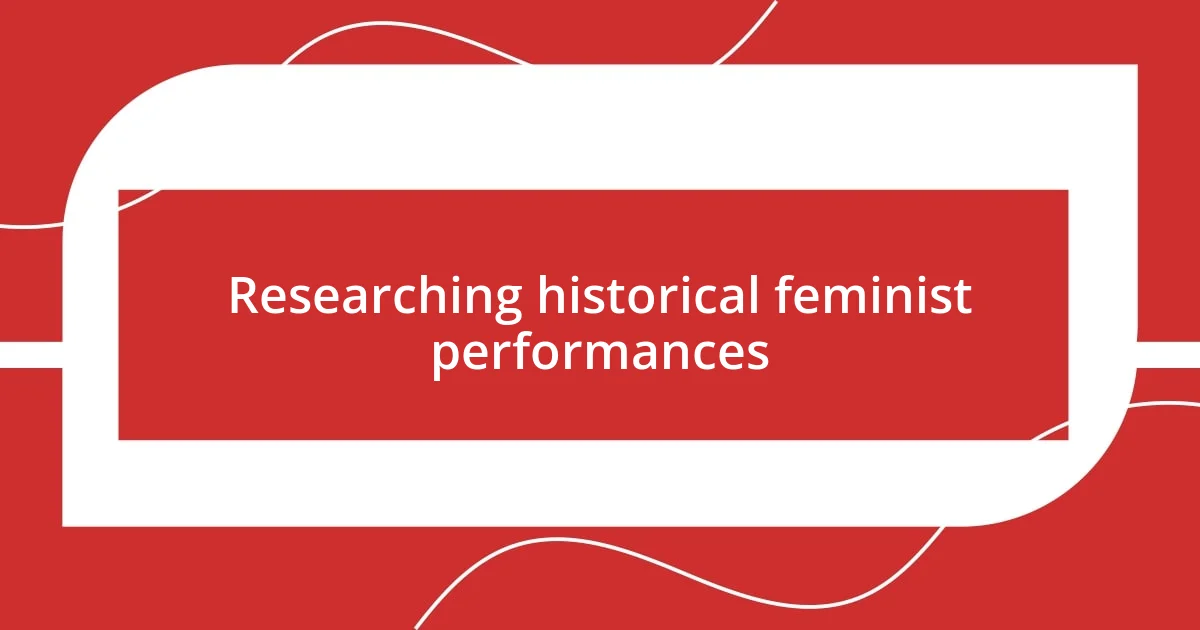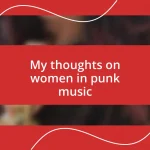Key takeaways:
- Feminist performances aim to reclaim silenced narratives and explore intersectionality, prompting dialogue and inspiring change.
- Personal influences, such as familial stories and literature, shape the creation of multi-dimensional characters and challenge traditional roles.
- Choosing powerful symbols and evaluating audience impact are essential for enhancing feminist messages and fostering community engagement through art.

Understanding feminist themes in performance
Feminist themes in performance are incredibly diverse, often focusing on the social, political, and personal experiences of women. I remember a piece I once performed, where I embodied the story of historical women whose voices have been silenced. It struck me how each character’s struggle resonated with my own encounters; I found myself questioning: How many narratives are left untold simply because they don’t fit into traditional molds?
Another significant aspect is the exploration of intersectionality, which considers how various identities—like race, sexuality, and class—interact with gender. I vividly recall performing in a collaborative project that blended stories from different cultures, highlighting how each perspective added a unique layer to the overall narrative. It made me reflect on my own identity: how do my experiences shape the stories I choose to tell?
The emotional connection that feminist performances create is palpable. I’ve seen the audience stirred, sometimes even moved to tears, as they witness a reclaiming of narratives that have long been overlooked. It begs the question: how can art not just reflect society but also challenge and reshape it? As I dive into feminist themes, I truly believe that each performance is an opportunity to spark dialogue and inspire change.

Identifying personal feminist influences
To identify personal feminist influences, I often reflect on the women in my life who’ve shaped my understanding of feminism. For instance, my grandmother’s tales of resilience inspired me to incorporate the struggles of past generations into my performances. It’s powerful to consider how her courage echoes through my art, reminding me that I am part of a continuum of voices striving for equality.
I also look at literature that has spoken to my feminist sensibilities. Books like “The Handmaid’s Tale” by Margaret Atwood have shown me the dangers of silencing women’s voices. I remember vividly reading it late at night, feeling that urgency to make my performances a platform for liberating stories that resonate with those experiencing oppression. It’s about carrying that weight into my work and transforming it into something that ignites passion in my audiences.
Another layer of my feminist influences comes from attending workshops and connecting with fellow artists. In one session, I was struck by a discussion on the male gaze in theater and how it alters narrative perspective. This sparked a personal commitment to rewriting traditional roles, ensuring that my characters own their narratives rather than being mere objects. How often do we see the same tired tropes? By challenging them in my performances, I aim to foster an environment where diverse stories can thrive and inspire others to do the same.
| Influence | Impact on Performance |
|---|---|
| Grandmother’s stories | Inspires incorporation of historical struggles |
| Literature, e.g., “The Handmaid’s Tale” | Instills urgency to liberate silenced narratives |
| Workshops with artists | Encourages challenging traditional roles |

Researching historical feminist performances
Researching historical feminist performances has always been a fascinating journey for me. I find that diving into the past reveals a treasure trove of influential works and figures that paved the way for today’s feminist art. Each discovery amplifies my understanding of how these performances not only expressed resistance but also created a space for dialogue that resonates with contemporary themes. For instance, learning about the groundbreaking work of Judith Malina from the Living Theatre opened my eyes to the idea of performance as a revolutionary act, stirring deep emotional responses and thoughts.
- I often delve into the work of feminist theater collectives like the Split Britches, who brought queer identities to the forefront of performance, intertwining humor and politics deftly.
- The visceral content in Anna Deavere Smith’s solo performances reminds me of the power of voice, as she weaves real-life experiences into her work, amplifying marginalized perspectives.
- I also explore the writings of performance theorist Peggy Phelan, whose emphasis on the ephemerality of performance challenges me to think critically about what messages linger even after the curtain falls.
In reflecting on these historical influences, I feel a personal connection to the struggles articulated by these trailblazers. Their stories often ignite my passion, pushing me to embody themes of empowerment and resilience in my own performances.

Analyzing audience perceptions of feminism
The audience’s perception of feminism can often be complex and layered. I remember performing a piece centered around women’s rights, only to overhear a conversation afterward about how some in the audience felt it was too aggressive. This really made me wonder: Are we still battling outdated notions of feminism that label strong voices as abrasive? It’s intriguing how personal experiences and societal narratives shape perceptions, often leading to misconceptions about the essence of feminist dialogue.
In another performance, I incorporated humor to tackle serious feminist issues, and the response was telling. I saw many nodding in recognition, but there were also those who seemed uncomfortable, laughing nervously. This moment made me reflect on how humor can serve as a bridge or a barrier. How do I create a space where all viewers can engage with these narratives openly? It spurred me to consider the importance of context and delivery in framing feminist themes for diverse audiences.
Ultimately, I’ve learned that understanding audience perceptions requires active engagement. I often host talkbacks after performances, which provide invaluable insight into how the themes resonate. During one such session, an audience member shared how the performance challenged her to reconsider her own beliefs about gender roles. It’s these interactions that fuel my passion; they remind me that art can be a catalyst for change, inviting us all to rethink and reflect together.

Integrating feminist narratives into scripts
Integrating feminist narratives into scripts requires a thoughtful approach. I often find myself asking, “How can I ensure that the voices of women and marginalized groups are not just present but central to the story?” One memorable instance involved a piece I was developing, where I wove in the experiences of women from different cultural backgrounds. By crafting multi-dimensional characters who reflected their struggles and triumphs, I aimed to create a narrative that resonated deeply and invited empathy from the audience.
I also think about language’s power in shaping narratives. In one script, I chose to highlight women’s perspectives through monologues that challenged societal expectations. This not only showcased their inner lives but also sparked discussions about identity and resistance. After performing this piece, a fellow artist approached me, expressing how the dialogue felt like unlocking a conversation that had been long overdue. Isn’t that what we strive for? Creating scripts that not only tell stories but ignite curiosity and dialogue?
Moreover, I incorporate various artistic styles and mediums to enrich feminist narratives. For example, I experimented with incorporating visual art and music to complement the text. In one performance, the use of live art as a backdrop transformed the atmosphere and emphasized the emotional weight of the story. It reminded me that every element in a performance can contribute to its feminist message. How can we make our narratives not just heard but felt? That’s the question that drives me to continue pushing boundaries in scriptwriting.

Choosing symbols to represent feminism
Choosing symbols to represent feminism is a deeply personal yet universal journey. I remember selecting a specific piece of jewelry—a bold pendant shaped like a fist—for one of my performances. To me, it symbolized strength and resilience. When I wore it on stage, the connection was palpable; I could see audience members visibly inspired. Isn’t it fascinating how a simple object can evoke powerful emotions and spark conversations about empowerment?
In another instance, I opted for the color purple, historically associated with the suffragette movement, as a dominant theme in my set design. Each shade represented a different aspect of women’s struggles and triumphs. While performing amidst this vibrant backdrop, I noticed how the color not only captured attention but also reinforced the narrative I aimed to convey. Have you ever thought about how the colors and symbols around us shape our understanding of important topics? It’s intriguing to see that even subtle choices can enhance the message we want to express.
I also try to incorporate flora, specifically the lotus flower, which symbolizes rebirth and new beginnings. During one performance, I utilized a visual projection of blooming lotuses to reflect transformation and growth in women’s rights. It was a moment that connected deeply with my audience. They were witnessing a blossoming narrative that echoed in their own lives. How can such images amplify a message? They remind us that feminism is not just about struggle; it’s also about beauty, hope, and renewal. Engaging the audience through carefully chosen symbols creates a richer, more immersive experience that resonates long after the curtain falls.

Evaluating the impact of performances
Evaluating the impact of performances is crucial not just for personal growth but also for understanding audience reception. I recall a feedback session after one of my shows, where a woman shared how a character’s journey mirrored her own struggles with societal pressures. That moment solidified for me that performances can serve as mirrors, reflecting personal experiences and fostering connection. Isn’t it incredible how art can become a vehicle for shared understanding?
I often analyze audience reactions immediately after a performance, noting everything from expressions to lingering conversations. During one show that focused on sexual empowerment, I noticed many attendees stayed afterwards, discussing their thoughts and insights. This sparked a vibrant dialogue that I believe is essential—have you experienced that rush of energy when art ignites a conversation? It was a clear indication that my work wasn’t just entertainment; it was a catalyst for change.
I also pay close attention to the long-term effects of my performances. For instance, months later, I caught up with a participant of a workshop I conducted, who shared that they had organized a community event to discuss feminism in their local area. Hearing how my work inspired that initiative was profoundly gratifying. It reinforces my belief that every performance has the potential to reverberate throughout communities, creating ripples of awareness and action. How do we measure the true impact of our art if not through such empowering stories?















